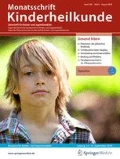Zusammenfassung
Es werden 2 Kinder vorgestellt (7jähriges Mädchen und 11jähriger Junge) mit einer seltenen Form der Neuroborreliose. Betroffen waren N. opticus und N. abducens. Klinisch fanden sich eine beidseitige Papillenprominenz sowie ein Strabismus convergens bedingt durch eine Parese des VI. Hirnnerven. Zusätzlich bestanden Kopfschmerzen, so daß primär eine intrakraniale Raumforderung mittels Kernspintomographie ausgeschlossen wurde. Die weitere Diagnostik ergab eine mononukleäre Liquorpleozytose, und es ließen sich in Serum und Liquor spezifische Antikörper gegen Borrelia burgdorferi nachweisen. Somit ergab sich die Diagnose einer Neuroborreliose mit Neuritis und Papillitis nervi optici und Neuritis nervi abducentis. Wenige Tage bis Wochen nach einer i.v.-Therapie mit Ceftriaxon war der klinische Befund unauffällig. Diskussion: Bei ungeklärten Hirnnervenparesen und Papillenprominenz muß nach Ausschluß einer intrakranialen Raumforderung an eine Neuroborreliose gedacht werden. Davon zu trennen ist ein isolierter Befall des Auges im Sinn einer okularen späten Lyme-Borreliose.
Summary
We report on two children (7-year-old girl; 11-year-old boy) with an unusual manifestation of neuroborreliosis involving the nervus opticus and nervus abducens. Both children had a bilateral oedema of the optic disk and a strabismus convergens caused by paralysis of the 6th cranial nerve. Since, in addition, the children presented with headache, initially an intracranial tumor was considered but then excluded by magnetic resonance imaging. The cerebrospinal fluid showed a mononuclear pleocytosis, and specific antibodies against Borrelia burgdorferi were detected in serum and in CSF. These results confirmed the diagnosis of ”neuroborreliosis”. All clinical manifestations disappeared a few days to weeks after treatment with intravenous ceftriaxon. Discussion: In the presence of cranial nerve palsy and optic disk oedema of unknown origin neuroborreliosis may be the correct diagnosis. Isolated involvement of the eye in the late stage of Lyme borreliosis is distinct from neuroborreliosis with cranial nerve involvement.
Author information
Authors and Affiliations
Rights and permissions
About this article
Cite this article
Böhme, M., Huppertz, HI. Neuroborreliose mit Papillenprominenz und Abduzensparese. Monatsschr Kinderheilkd 146, 17–19 (1998). https://doi.org/10.1007/s001120050239
Issue Date:
DOI: https://doi.org/10.1007/s001120050239

